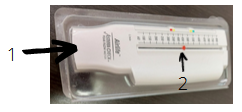Devices and Resources
Airway Clearance
Some breathing conditions, commonly in COPD, will make mucus build up in the chest making it harder to breathe and increasing the risk of having a chest infection. Using one or more of the following techniques to bring up mucus regularly may reduce daily symptoms and reduce the frequency of chest infections.
Techniques to bring up mucus from your chest:
The ‘Ha’ or ‘huff’ cough
Sit on a chair with your feet flat and slightly leaning forward. Take a breath that is slightly deeper than normal and use your stomach muscles to make a series of 2-3 rapid exhalations with the airway open, making a ‘ha’ sound. Follow this by controlled diaphragmatic breathing and a deep cough if you feel mucus moving.
Deep or Controlled Cough
Start by taking a deep breath. Hold the breath for 2-3 seconds. Use your stomach muscles to make two short coughs. Avoid a hacking cough or merely clearing the throat to avoid hurting it. Relax for a few seconds.
Postural drainage
You can let gravity help you clear your chest by taking various positions of sitting up or laying down at different inclines. Optionally you can have a person help you by clapping you on the chest or vibrating to loosen the mucus.
There are also massage parlours and physiotherapists in your local area that can perform these assisted postural drainage techniques.
Aerobika device
The AEROBIKA device helps to thin and loosen mucus, helping move it to the larger airways of your lungs, where it can be coughed out.
Incentive Spirometer
An incentive spirometer is a device that trains you to take slow deep breaths.
Most of the spirometers consist of a mouth piece to breath through and a cyclinder containing either balls or a piston. The cylinder is marked up to allow visual feedback. The stronger the breath the more the piston moves. This helps you monitor your breathing, as well as measure progress.
An incentive spirometer is helpful in situation where patients are bedridden due to illness, recent surgery or other interventions, they often develop atelectasis which are poorly ventilated areas of the lungs. An incentive spirometer is often prescribed in hospital to promote lung expansion, improve ventilation and reduce atelectasis.
It can also be helpful for patients who have a limited ability to walk (eg: wheelchair bound).
How to use it
- Take a deep breath.
- Hold your breath for 2 to 6 seconds.
- Exhale completely.
- Repeat a few times.
With deep breathing, it is natural to feel lightheaded. In this case, pause the exercise for a few minutes until you feel better.
Peak flow meter
A peak flow meter esimates the peak expiratory flow rate (PEF), or the fastest speed with which the air can be exhaled from the lungs. PEF indicates how well the air is moving through the lungs. Low PEF measurements or high variability of results can indicate the worsening of asthma.
Therefore a peak flow meter is a good tool for monitoring your asthma at home, including daily monitoring.
Repeated measurements can provide your personal best PEF or point of reference. If you’ve never measured PEF before, refer to the chart inclosed with most peak flow meters, to estimate your expected results.
Your measurement can then be graded according to zones which indicate good or bad control of asthma. Typically, 80% of your best PEF is green zone, 80%-50% is yellow zone and below 50% is red zone and indicates you should see a doctor. Talk to your doctor about an asthma plan.
How to use it
It is best to use the peak flow meter while standing or sitting upright.
- Inhale as deeply as you can.
- Blow out as hard and fast as you can into the mouthpiece (1).
- This will move the marker (2).
- Take note of the reading.
- Move the marker back to its zero position.
- Repeat 2 more times for a total of 3 attempts.
- Record the best reading.

Oximeter
An oximeter is a device that estimates the level of oxygen in your blood, non-invasively. It uses a light beam to measure the percentage of oxygen in red blood cells.
Typically, low levels should be confirmed with a blood sample.
To use a pulse oximeter, you simply clip it to your finger. Most oximeters provide reading of oxygen saturation and pulse.
The pulse should correspond to the one measured by palpation at the wrist. The signal indicator (wave or bar) should display a strong signal. Allow a few seconds to establish a reliable reading.
An oximeter is helpful for individuals with chronic lung disease. Your doctor can advise you if it is useful to monitor your level of oxygen or whether you are at risk for having low oxygen.
For those who receive supplemental oxygen therapy, monitoring your oxygen level helps to maintain it at the target recommended by your health care provider.
Just being short of breathe doesn’t mean that your oxygen level is low.
What can affect the readings?
An oximeter is an non-invasive measurement, so it can be affected by:
- Poor circulation,
- Cold skin temperature,
- Dark skin pigmentation,
- Artificial nails or dark nail polish.
Normal oxygen levels measured by an oximeter are ≥92%.

